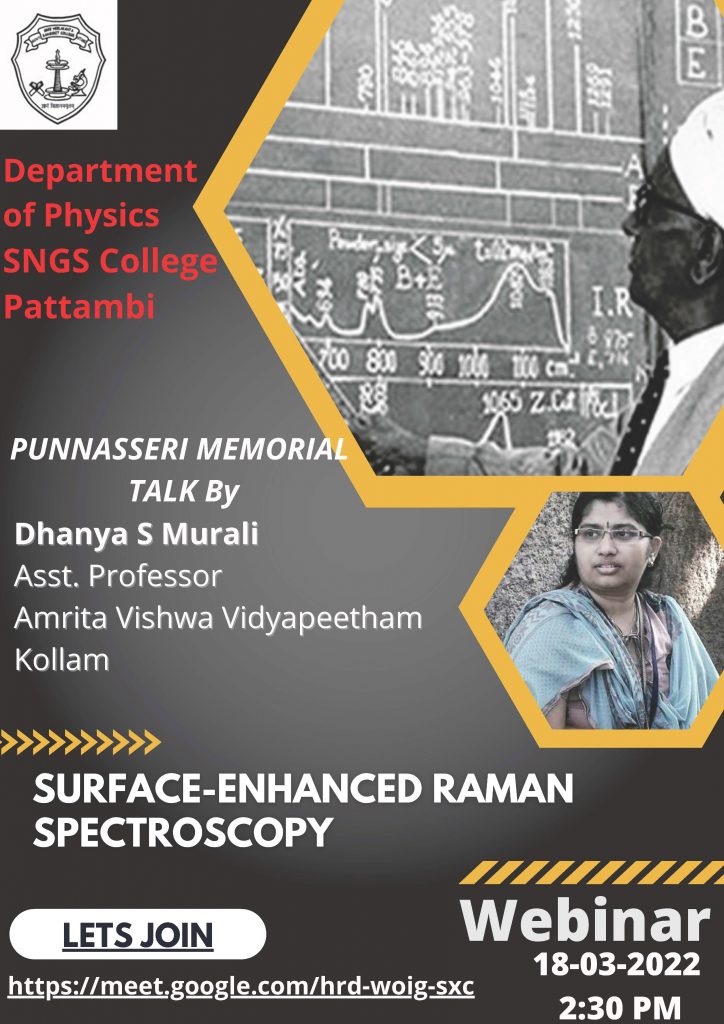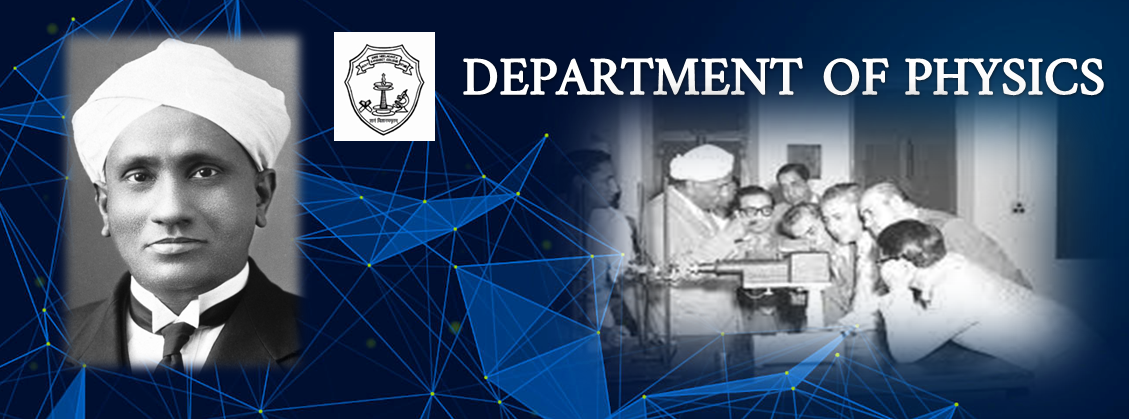
Department of Physics started functioning in the year 1967 to offer courses in the now discontinued Pre Degree Course. Department of Physics started offering 3 year Bachelor of Science Program in Physics in the year 2012 with Mathematics and Chemistry as subsidiary subjects. The department has well equipped general physics laboratories for subsidiary and main course as well as a dark room to conduct optics experiments. The department also possess a computer laboratory and a project laboratory with moderate research facilities.
Courses Offered
| COURSE | DURATION | STREANGTH |
| B.Sc. Physics | 3 years
(6 Semesters) |
24
(sanctioned strength) |
Faculty Profile
| NO | NAME | Designation | Qualification | Phone | ||
| 1 | Lisha C L | Asst
Professor |
M.Sc, Bed,
JRF,NET |
lishacl9@gmail.com | 7907662789 |  |
| 2 | Rajesh K P | Asst. Professor
|
M.Sc. Physics, Ph.D |
rajeshptb@gmail.com |
8943258800 |
 |
| 3 | Shihabudheen.M | Asst. Professor
|
MSc, BEd, NET | shihabudheenm@gmail.com
|
9605767781 |  |
| 4 | LINSHA C. L. | Asst. Professor | MSc., B Ed, NET | linshacl15@gmail.com
|
9605527820
|
 |
Programme Outcome
PSO1: Understand the basic concepts of methodology of science and the fundamentals of mechanics, properties of matter and electrodynamics
PSO2: Understand the theoretical basis of quantum mechanics, relativistic physics, nuclear physics, optics, spectroscopy, solid state physics, astrophysics, statistical physics, photonics and thermodynamics
PSO3: Understand and apply the concepts of electronics in the designing of different analog and digital circuits
PSO4: Understand the basics of computer programming and numerical analysis
PSO5: Apply and verify theoretical concepts through laboratory experiments
Students Profile
- Qualification for Admission: Plus Two Science Stream with Physics as one of the subject
- Present Number and categories :
| Class | UG I | UG II | UG III | PG I | PG II |
| Sanctioned Strength | 40 | 39 | 32 | ||
| No. Of Students Admitted | 38 | 38 | 31 | ||
| No of present students | 33 | 35 | 29 | ||
| Boys | 9 | 10 | 9 | ||
| Girls | 24 | 25 | 20 | ||
| SC | 7 | 6 | 4 | ||
| ST | 1 | 2 | 1 | ||
| OBC and Minority | 17 | 14 | 16 | ||
| General | 8 | 13 | 8 |
- Achievements of Students
| NO | Name of the Student | NET / JRF | Year |
| 1 | Reshmi S R | NET | 2017 |
| 2 | Vidhya P. | Temporary Assistant/ Telecom in the signal and Telecom branch of Chennai division | 2019 |
| 3 | Vismaya K. T. | JAM 2017 | 2017 |
| 4 | Sandeep | JAM 2020 | 2020 |
| 5 | Varun V | JAM 2020 | 2020 |
| 6 | Aiswarya M P | JAM 2021 | 2021 |
| 7 | Nusla | JAM 2021 | 2021 |
- Ranks :
2016 University Topper- Fourth Position Reshmi S R (CGPA 3.85 out of 4)
2017 University Topper- Second Position VISMAYA K T (CGPA 5.75 out of 6)
Recent Curricular Changes
The curriculum of B.Sc Physics was revised in 2019 under CBCSS UG Regulations
Learning Resources & Facilities
- Computer Laboratory
- Smart TV
- LCD Projector
- Learning Management System (LMS)
Research Projects & Publications
Publications
- C. Lohithakshan, Geetha V. and Kannan P., 2020, Single polymer-variable index for the design and fabrication of variable stop band distributed Bragg reflectors, Optical Materials, 110, p.110509. (Impact factor 3.08)
- C. Lohithakshan, Pattarathil M.S., Geetha V. and Kannan P., 2020 July., Photoluminescent Glucose Derived Carbon Quantum Dots for Photonic and Optoelectronic Applications., In Optical Devices and Materials for Solar Energy and Solid-state Lighting(pp. JTu4C-12). Optical Society of America (Conference Proceedings)
- C. Lohithakshanand Kannan P., Realisation of optical filters using multi-layered thin film coatings by transfer matrix model simulations (Materials Today Proceedings: Accepted for publication)
Conference Presentation
1) Lisha. C. Lohithakshan1, Mohammed Shafeeq Pattarathil2, Vishnu Geetha1 and Pradeesh Kannan1, “Photoluminescent Glucose Derived Carbon Quantum Dots for Photonic and Optoelectronic Applications” International conference on OSA Advanced Photonic Congress 2020.
2)Lisha. C. Lohithakshanand and Pradeesh Kannan, “Design and optimization of distributed Bragg reflectors using transfer matrix model simulations” International conference on Recent Trends in Photonics (NPS2021)
3)Lisha. C. Lohithakshanand Pradeesh Kannan, “Quantum dots and its photonic and biomedical applications” National symposium on Advanced materials.
4)Lisha. C. Lohithakshan and Pradeesh Kannan,“Realisation of optical filters using multi-layered thin film coatings by transfer matrix model simulations” International conference on Recent advances in engineering materials (ICRAEM 2022)
Academic Activities & Initiatives
1.Online webinar on “Surface Enhanced Raman Spectroscopy” on 18th March, 2022 .
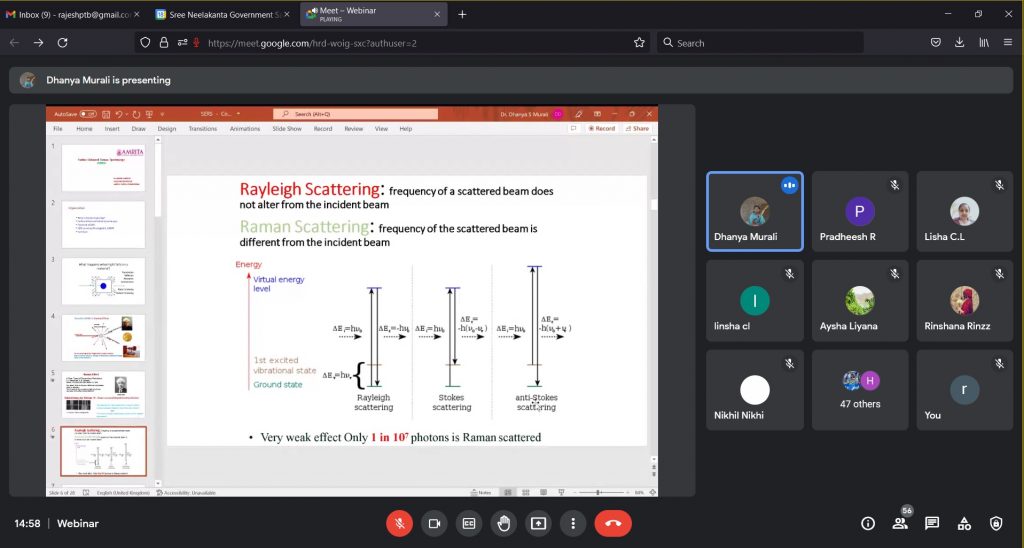
2.Online webinar on “General Relativity, expanding universe and Big Bang” on 8th March, 2021.
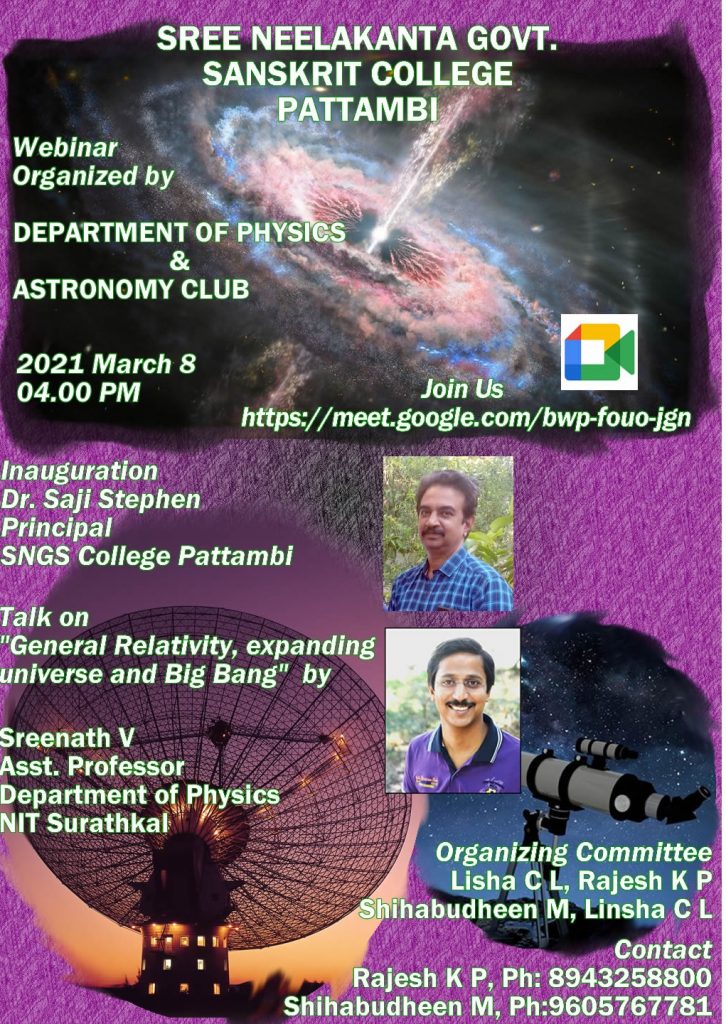
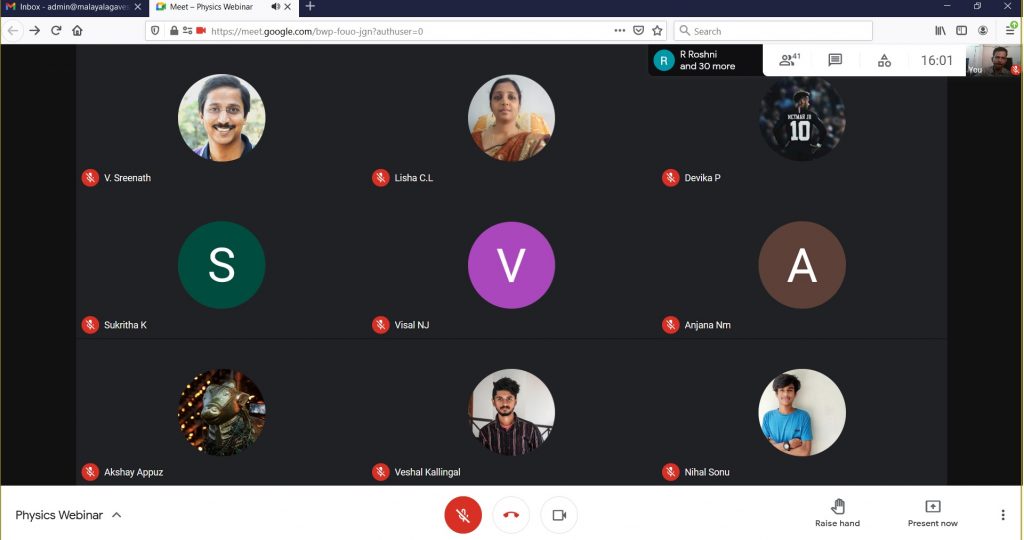
3.Two day National Seminar on “Recent Trends in Physics” on Nov. 21st and 22nd, 2019
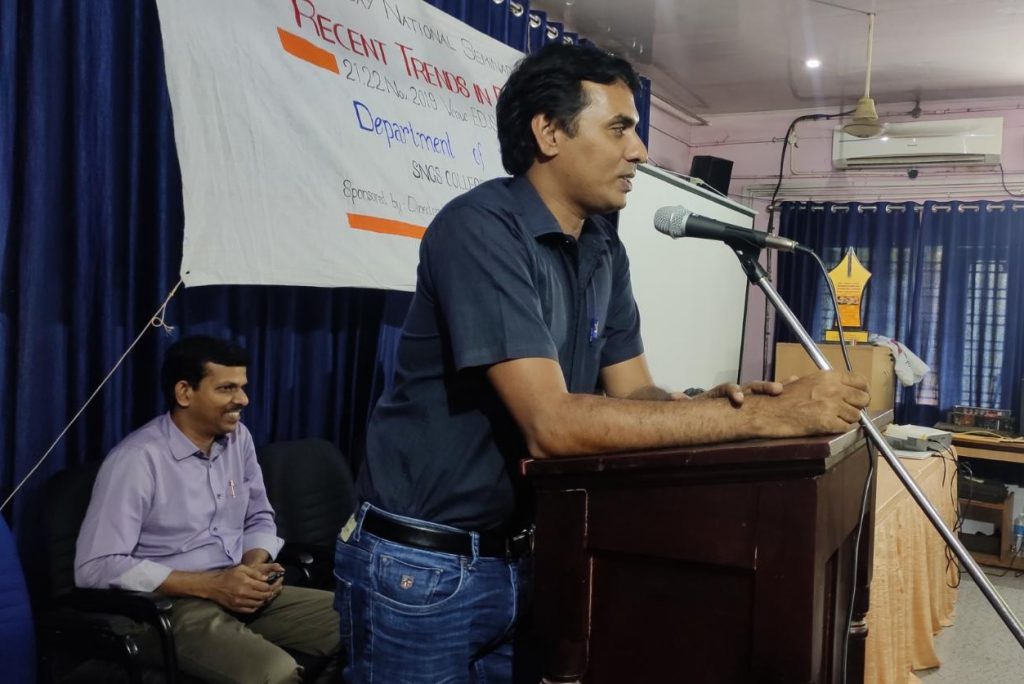
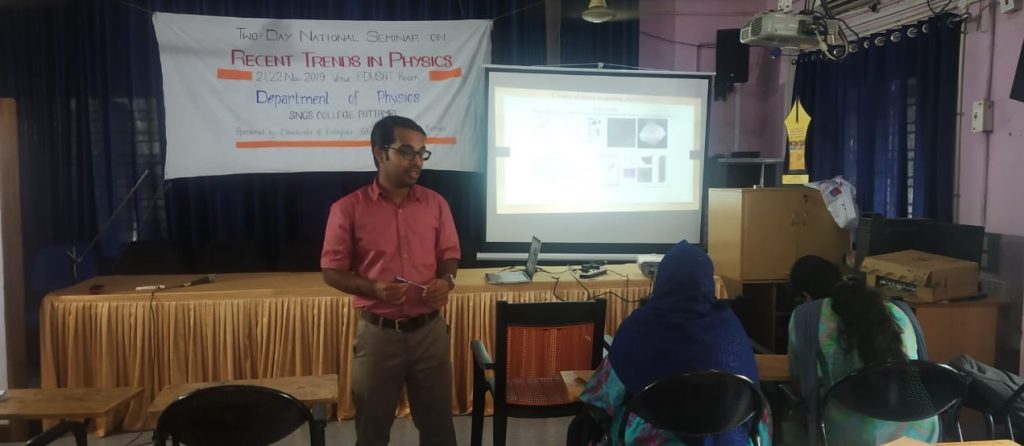
4.National Work Shop on ‘ La-Tex – a document preparation system ” on Nov 13th, 2018
5.National Work Shop on ‘Nano Science and Technology NT2K17’ on 21st Dec , 2017

Core Course Structure
| Semester | Code No | Course Title | Hours/
Week |
Total
Hours |
Credit | Marks | |
|
1 |
PHY1B01 | Core Course I: Methodology of Science
and Basic Mechanics |
2 | 36 | 2 | 75 | |
| 2 | PHY2B02 | Core Course II: Mechanics | 2 | 36 | 2 | 75 | |
| 3 | PHY3B03 | Core Course III: Electrodynamics-I | 3 | 54 | 3 | 75 | |
| 4 | PHY4B04 | Core Course IV: Electrodynamics-II | 3 | 54 | 3 | 75 | |
| PHY4B05 | Core Course V : Practical-I | 2 | 36 | 5 | 100 | ||
|
5 |
PHY5B06 | Core Course VI: Computational Physics | 3 | 54 | 3 | 75 | |
| PHY5B07 | Core Course VII: Quantum Mechanics | 3 | 54 | 3 | 75 | ||
| PHY5B08 | Core Course VIII: Optics | 3 | 54 | 3 | 75 | ||
| PHY5B09 | Core Course IX: Electronics (Analog and
Digital) |
3 | 54 | 3 | 75 | ||
|
6 |
PHY6B10 | Core Course X: Thermodynamics | 3 | 54 | 3 | 75 | |
| PHY6B11 | Core Course XI: Statistical Physics, Solid
State Physics, Spectroscopy and Photonics |
3 | 54 | 3 | 75 | ||
| PHY6B12 | Core Course XII: Nuclear Physics and
Particle Physics |
3 | 54 | 3 | 75 | ||
| PHY6B13 | Core Course XIII Relativistic mechanics
and Astrophysics |
3 | 54 | 3 | 75 | ||
| PHY6B14 (EL2) | Core Course XIV: Elective*** | 2. Nanoscience and
Technology |
3 |
54 |
3 |
75 |
|
| PHY6B15 | Core Course XV: Practical -II | 4 | 72 | 5** | 100 | ||
| PHY6B16 | Core Course XVI: Practical-III | 4 | 72 | 5** | 100 | ||
| PHY6B17
(P/R) |
Core Course XVII: Project Work /Research Methodology and Tour Report | 2
1 |
36 | 3** | 60
15 |
||
Abbreviations used:
CL – Cognitive level; U – understand; Ap – apply; An – analyze; C – create KC – Knowledge category; C – conceptual; F – factual; P – procedural
Semester 1 Core Course I
PHY1B01: METHODOLOGY OF SCIENCE AND BASIC MECHANICS
|
Course Outcome |
PSO |
CL |
KC |
|
| CO1 | Understand the features, methods and limitations of science | PSO1 | U | C |
|
CO2 |
Understand and apply the basic concepts of Newtonian Mechanics to physical
systems |
PSO1 |
Ap |
C, P |
| CO3 | Understand and apply the basic idea of work-energy theorem to physical systems | PSO1 | Ap | C,P |
| CO4 | Understand and apply the rotational dynamics of rigid bodies | PSO1 | Ap | C,P |
| CO5 | Understand the basic ideas of elasticity | PSO1 | U | C |
Semester 2 | Core Course II
PHY2B02: MECHANICS
|
Course Outcome |
PSO |
CL |
KC |
|
| CO1 | Understand the features of non-inertial systems and fictitious forces | PSO1 | U | C |
|
CO2 |
Understand and analyze the features of
central forces with respect to planetary motion |
PSO1 |
An |
C, P |
| CO3 | Understand the basics ideas of harmonic oscillations | PSO1 | U | C |
| CO4 | Understand and analyze the basics concepts of wave motion | PSO1 | An | C,P |
Semester 3 | Core Course III
PHY3B03: ELECTRODYNAMICS I
|
Course Outcome |
PSO |
CL |
KC |
|
| CO1 | Understand and apply the fundamentals of vector calculus | PSO1 | Ap | C |
| CO2 | Understand and analyze the electrostatic properties of physical systems | PSO1 | An | C, P |
| CO3 | Understand the mechanism of electric field in matter. | PSO1 | U | C,P |
| CO4 | Understand and analyze the magnetic properties of physical systems | PSO1 | An | C,P |
| CO5 | Understand the mechanism of magnetic
field in matter. |
PSO1 | U | C,P |
Semester 4 | Core Course IV
PHY4B04: ELECTRODYNAMIC II
|
Course Outcome |
PSO |
CL |
KC |
|
| CO1 | Understand the basic concepts of electrodynamics | PSO1 | U | C |
| CO2 | Understand and analyze the properties of electromagnetic waves | PSO1 | An | C, P |
| CO3 | Understand the behavior of transient currents | PSO1 | U | C |
| CO4 | Understand the basic aspects of ac circuits | PSO1 | An | C,P |
| CO5 | Understand and apply electrical network
theorems |
PSO1 | Ap | C,P |
Semester 5Core Course –VI
PHY5B06: COMPUTATIONAL PHYSICS
|
Course Outcome |
PSO |
CL |
KC |
|
| CO1 | Understand the Basics of Python programming | PSO4 | U | C |
| CO2 | Understand the applications of Python modules | PSO4 | U | C |
| CO3 | Understand the basic techniques of numerical analysis | PSO4 | U | C |
| CO4 | Understand and apply computational techniques to physical problems | PSO4 | Ap | C,P |
Semester 5Core Course –VII
PHY5B07: QUANTUM MECHANICS
|
Course Outcome |
PSO |
CL |
KC |
|
| CO1 | Understand the particle properties of electromagnetic radiation | PSO2 | U | C |
| CO2 | Describe Rutherford – Bohr model of the atom | PSO2 | U | C |
| CO3 | Understand the wavelike properties of particles | PSO2 | U | C |
| CO4 | Understand and apply the Schrödinger equation to simple physical systems | PSO2 | Ap | C,P |
| CO5 | Apply the principles of wave mechanics to
the Hydrogen atom |
PSO2 | Ap | C,P |
Semester 5 | Core Course VIII
PH5B08: OPTICS
|
Course Outcome |
PSO |
CL |
KC |
|
| CO1 | UnderstandthefundamentalsofFermat‟sprinciples and geometrical optics | PSO2 | U | C |
| CO2 | Understand and apply the basic ideas of interference of light | PSO2 | Ap | C, P |
| CO3 | Understand and apply the basic ideas of diffraction of light | PSO2 | Ap | C, P |
| CO4 | Understand the basics ideas of polarization of light | PSO2 | U | C |
| CO5 | Describe the basic principles of
holography and fibre optics |
PSO2 | U | C |
Semester 5Core Course –IX
PHY5B09: ELECTRONICS (ANALOG & DIGITAL)
|
Course Outcome |
PSO |
CL |
KC |
|
| CO1 | Understand the basic principles of rectifiers and dc power supplies | PSO3 | U | C |
| CO2 | Understand the principles of transistor | PSO3 | U | C |
| CO3 | Understand the working and designing of transistor amplifiers and oscillators | PSO3 | Ap | C, P |
| CO4 | Understand the basic operation of Op – Amp and its applications | PSO3 | U | C |
| CO5 | Understand the basics of digital electronics | PSO3 | U | C |
Semester 6 | Core Course X
PHY6B10: THERMODYNAMICS
|
Course Outcome |
PSO |
CL |
KC |
|
| CO1 | Understand the zero and first laws of thermodynamics | PSO2 | U | C |
| CO2 | Understand the thermodynamics description of the ideal gas | PSO2 | U | C |
| CO3 | Understand the second law of thermodynamics and its applications | PSO2 | U | C, P |
| CO4 | Understand the basic ideas of entropy | PSO2 | U | C |
|
CO5 |
Understand the concepts of thermodynamic potentials and phase
transitions |
PSO2 |
U |
C |
Semester 6: Core Course XI
PHY6B11: STATISTICAL PHYSICS, SOLID STATE PHYSICS, SPECTROSCOPY & PHOTONICS
|
Course Outcome |
PSO |
CL |
KC |
|
| CO1 | Understand the basic principles of statistical physics and its applications | PSO2 | U | C |
| CO2 | Understand the basic aspects of crystallography in solid state physics | PSO2 | U | C |
| CO3 | Understand the basic elements of spectroscopy | PSO2 | U | C |
| CO4 | Understand the basics ideas of microwave and infra red spectroscopy | PSO2 | U | C |
| CO5 | Understand the fundamental ideas of
photonics |
PSO2 | U | C |
Semester 6: Core Course XII
PHY6B12: NUCLEAR PHYSICS AND PARTICLE PHYSICS
|
Course Outcome |
PSO |
CL |
KC |
|
| CO1 | Understand the basic aspects of nuclear structure and fundamentals of radioactivity | PSO2 | U | C |
| CO2 | Describe the different types of nuclear reactions and their applications | PSO2 | U | C, P |
| CO3 | Understand the principle and working of particle detectors | PSO2 | U | C, P |
| CO4 | Describe the principle and working of particle accelerators | PSO2 | U | C, P |
| CO5 | Understand the basic principles of
elementary particle physics |
PSO2 | U | C |
Semester 6 | Core Course XIII
PHY6B13: RELATIVISTIC MECHANICS AND ASTROPHYSICS
|
Course Outcome |
PSO |
CL |
KC |
|
| CO1 | Understand the fundamental ideas of special relativity | PSO2 | U | C |
| CO2 | Understand the basic concepts of general relativity and cosmology | PSO2 | U | C |
| CO3 | Understand the basic techniques used in astronomy | PSO2 | U | C |
| CO4 | Describe the evolution and death of stars | PSO2 | U | C |
| CO5 | Describe the structure and classification of
galaxies |
PSO2 | U | C |
Semester 6 | Core Course XIV (Elective)
PHY6B14 (EL2): NANOSCIENCE AND TECHNOLOGY
|
Course Outcome |
CL |
KC |
|
| CO1 | Understand the elementary concepts of nanoscience | U | C |
| CO2 | Understand the electrical transport mechanisms in nanostructures | U | C |
| CO3 | Understand the applications of quantum mechanics in nanoscience | U | C |
|
CO4 |
Understand the fabrication and
characterization techniques of nanomaterials |
U |
C |
| CO5 | Enumerate the different applications of
nanotechnology |
U | C |
Semesters 1 to 4 | Core Course V
PHY4B05: PRACTICAL I
|
Course Outcome |
CL |
KC |
|
| CO1 | Apply and illustrate the concepts of properties of matter through experiments | Ap | P |
|
CO2 |
Apply and illustrate the concepts of electricity and magnetism through experiments |
Ap |
P |
| CO3 | Apply and illustrate the concepts of optics through experiments | Ap | P |
| CO4 | Apply and illustrate the principles of electronics through experiments | Ap | P |
Semesters 5-6 | Core Course XV
PHY6B15: PRACTICAL II
|
Course Outcome |
CL |
KC |
|
| CO1 | Apply and illustrate the concepts of properties of matter through experiments | Ap | P |
|
CO2 |
Apply and illustrate the concepts of electricity and magnetism through
experiments |
Ap |
P |
| CO3 | Apply and illustrate the concepts of optics and spectroscopy through experiments | Ap | P |
| CO4 | Apply and illustrate the principles of heat through experiments | Ap | P |
Semester 5-6 | Core Course XVI
PHY6B16: PRACTICAL III
|
Course Outcome |
CL |
KC |
|
|
CO1 |
Apply and illustrate the principles of semiconductor diode and transistor through
experiments |
Ap |
P |
|
CO2 |
Apply and illustrate the principles of transistor amplifier and oscillator through
experiments |
Ap |
P |
| CO3 | Apply and illustrate the principles of digital electronics through experiments | Ap | P |
| CO4 | Analyze and apply computational techniques in Python programming | Ap | P |
Semester 5-6 | Core Course XVII
Course: PHY6B17(P) – PROJECT
36 hours in each semester (Credits: 2)
|
Course Outcome |
CL |
KC |
|
| CO1 | Understand research methodology | U | P |
| CO2 | Understand and formulate a research project | C | P |
| CO3 | Design and implement a research project | C | P |
| CO4 | Identify and enumerate the scope and limitations of a research project | C | P |
Semester 5-6 | Core Course XVII
PHY6B17(R): RESEARCH METHODOLOGY (In lieu of Project)
36 hours in each semester (Credits: 2)
|
Course Outcome |
CL |
KC |
|
| CO1 | Understand research methodology | U | C, P |
| CO2 | Understand the concept of measurement in research | C | C, P |
| CO3 | Understand the significance and limitations of experimentation in research | C | C, P |
|
CO4 |
Understand and formulate a research
project, ethics and responsibility of scientific research |
C |
C, P |
Semester 5: Open Course I
PHY5D01(2): AMATEUR ASTRONOMY AND ASTROPHYSICS
|
Course Outcome |
CL |
KC |
|
| CO1 | Describe the history and nature of astronomy as a science | U | C |
| CO2 | Understand the motion of earth in space and the cause of seasons | U | C |
| CO3 | Understand the basic elements of solar system | U | C |
| CO4 | Understand the elementary concepts of solar system | U | C |
Semester 1: Complementary course-I PHY1C01: Properties of matter & Thermodynamics
36 hours (Credit – 2)
|
Course Outcome |
CL |
KC |
Class Sessionsallotted | |
| CO1 | Understand the basic principles of elasticity | U | C | 9 |
| CO2 | Understand the concepts of surface tension | U | C | 5 |
| CO3 | Understand the aspects of viscosity | U | C | 4 |
| CO4 | Understand the basic principles of thermodynamics | U | C | 18 |
Semester 2 | Complementary Course II PHY2C02: Optics, Laser &Electronics 36 hours (Credit – 2)
|
Course Outcome |
CL |
KC |
Class Sessions
allotted |
|
| CO1 | Understand the basic concepts of interference and diffraction | U | C | 16 |
| CO2 | Understand the concepts of polarization | U | C | 6 |
| CO3 | Understand the fundamentals of electronics | U | C | 10 |
| CO4 | Understand the important principles of laser physics | U | C | 4 |
Semester 3 | Complementary Course III PHY3C03: Mechanics, Relativity, Waves and Oscillations
54 hours (Credit – 3)
|
Course Outcome |
CL |
KC |
Class Sessions
allotted |
|
|
CO1 |
Understand the basic ideas of frames of reference and the principles of
conservation of energy and momentum |
U |
C |
22 |
| CO2 | Understand the concepts of relativity | U | C | 12 |
| CO3 | Understand the basic ideas of oscillations and waves | U | C | 10 |
| CO4 | Understand the basic ideas of modern physics | U | C | 10 |
Semester 4 | Complementary Course IV PHY4C04: Electricity, Magnetism and Nuclear physics
|
Course Outcome |
CL |
KC |
Class Sessions
allotted |
|
| CO1 | Understand the basic ideas of static and current electricity | U | C | 20 |
| CO2 | Understand the concepts of magnetism | U | C | 12 |
| CO3 | Describe the fundamental concepts of nuclear physics | U | C | 12 |
| CO4 | Understand the basic ideas of cosmic rays and elementary particles | U | C | 10 |
Semester 1 to 4 | Complementary Course V
PHY4C05: PHYSICS PRACTICAL I
|
Course Outcome |
CL |
KC |
Class Sessionsallotted | |
| CO1 | Apply and illustrate the concepts of properties of matter through experiments | Ap | P | 36 |
|
CO2 |
Apply and illustrate the concepts of electricity and magnetism through
experiments |
Ap |
P |
36 |
| CO3 | Apply and illustrate the concepts of optics through experiments | Ap | P | 36 |
| CO4 | Apply and illustrate the principles of electronics through experiments | Ap | P | 36 |
Placement Records
Annual Reports
Annual Report 2021-2022
About
The department of physics offers B.Sc. programme in Physics with an annual intake of 42 students. Due to Covid pandemic, the classes were conducted in both the online and offline mode. The department has four permanent faculties. The details of faculties are given below.
Faculty profile:
- Lisha C L
- Rajesh K P
- Shihabudheen M
- Linsha C L
Achievements:
Physics Department has an excellent achievement in the academic and extra-curricular activities. There is remarkable participation of our students in sports at the Inter-zone levels. Two of the final year students Aiswarya M P and Nuzla Zainaba P qualified JAM exam in 2022.
Seminar
Department of physics conducted an online webinar on “Surface Enhanced Raman Spectroscopy” on 18th March, 2022 at SNGS College, Pattambi. The webinar aims to inspire students to choose a scientific research career. Distinguished speakers from prestigious institutions delivered the lectures. The Coordinator of the webinar was Dr. Rajesh K P.
Annual Report 2020-21
About
The department of physics offers B.Sc. programme in Physics with an annual intake of 38 students. Due to Covid pandemic, the classes are conducted in online mode. The department has four permanent faculties. The details of faculties are given below.
Faculty profile:
- Lisha C L
- Rajesh K P
- Shihabudheen M
- Linsha C L
Achievements:
Physics Department has an excellent achievement in the academic and extra-curricular activities. There is remarkable participation of our students in sports at the Inter-zone levels.
Seminar
Department of physics conducted an online webinar on “General Relativity, Expanding Universe and Big Bang” on 8th March, 2021 at SNGS College, Pattambi. The webinar aims to inspire students to choose a scientific research career. Distinguished speakers from prestigious institutions delivered the lectures. The Coordinator of the seminar is Dr. Rajesh K P.
Annual Report 2019 – 2020
About
The department of physics offers B.Sc. programme in Physics with an annual intake of 36 students. The admission for B.Sc. physics course started on 10- June-2019 and finished on 22 -Aug -2019. The department has four permanent faculties. The details of faculties are given below.
Faculty profile:
- Lisha C L
M.Sc., JRF + NET, B.Ed.
- Dr. Rajesh K P
M.Sc., JRF + NET, Ph.D
- Shihabudheen M
M.Sc., JRF + NET
- Linsha C L
M.Sc. Physics, JRF +NET
Achievements:
Physics Department has an excellent achievement in the academic level. Out of the 45 students passed out, One student got admission for MSc Physics at NIT Surathkal and one at Central university of Kerala, Kasargod and 16 students got admission for M.Sc. Physics in Govt. & aided colleges. One student got admission for MLiblsc in Calicut university and One student got admission for BEd. There is remarkable participation of our students in sports at the Inter-zone levels. Our First Year students Parvathy S Nair had won the first runner up in the Inter-zone Womens Cricket Competition of Calicut University. Sreeraj K P secured second place in interzone WUSHU (men) Championship at Calicut University.
Seminar
Department of physics conducted a Two day National Seminar on “Recent Trends in Physics” on Nov. 21st and 22nd, 2019 at SNGS College, Pattambi. The seminar aims to inspire students to choose a scientific research career. Distinguished speakers from various institutions will be delivering the lectures and chance is given to research scholars to present their work. The Coordinator of the seminar is Shihabudheen M.
Study Tour
A study tour was conducted by the department of Physics to Dhandeli, Chikamanglur, Goa on 27th Nov 2019.
Annual Report 2018- 2019
About
The department of physics offers a B.Sc. programme in Physics with an annual intake of 48 students. The B.Sc .physics admission started on 19- June-2018 and finished on 26 -07 -2018. We have one permanent faculty & three Guest faculties. The details of faculties are given below.
Faculty profile:
- Lisha C L
MSc, JRF + NET, BEd.
- Satheesh N S
M.Sc., M.Phil. NET
- Sreekutty P V
M.Sc., JRF + NET
- Swathi M
M.Sc Physics
Achievements:
Physics Department has excellent achievements in the academic level and there are remarkable participation of physics students in sports in the interzone levels.
Workshops and Orientation Programmes Attended
Department of physics conducted a National Work Shop on ‘ La-Tex – a document preparation system ” on Nov 13th, 2018 at SNGS College, Pattambi. The workshop aims to have a basic knowledge of the document preparation with LaTeX with practical hands on training Unlike Microsoft Word, the LaTeX focuses on the content of the document rather than the appearance Since bibliographies and index can be easily handled with LaTeX, it is widely used in academia for the communication and publication of scientific documents in many fields, including mathematics, statistics, computer science, engineering, chemistry, physics, economics, linguistics, quantitative psychology, philosophy, and political science. A hand on training was given to various faculties from colleges and research scholars who are working in the area of mathematics, statistics, computer science, engineering, chemistry, physics, economics, linguistics, quantitative psychology, philosophy, and political science. All the sessions was handled by experts. The Coordinator of the Work Shop was Mrs. Lisha C L., Head of the Department of Physics. Mrs. Lisha C L. has attended a National Seminar on ‘Recent Trends in Material Science’ Organized by Department of Physics , Govt arts college , Kozhokkode.
Extension Activity
An outreach residential programme named ‘Sasthrajalakam’ for 9th standard students for creating scientific awareness is conducted at SreeNeelakanta Govt. Sanskrit College, Pattambi. The programme was funded by State Govt of Kerala. Physics Department actively participated in the programme In the morning session classes handled by eminent personalities and in the evening session various experiments are demonstrated in the lab.
Annual Report 2017- 2018
About
The department of physics offers a B.Sc. programme in Physics with an annual intake of 48 students. The B.Sc .physics admission started on 19- June-2018 and finished on 26 -07 -2018. We have one permanent faculty & three Guest faculties. The details of faculties are given below.
Faculty profile:
- Lisha C L
MSc, JRF + NET, BEd.
- Satheesh N S
M.Sc., M.Phil. NET
- Karthika Sankar
M.Sc., JRF + NET
- Saleena P V
M.Sc Physics
Achievements:
Physics Department has an excellent achievement in the academic level. Out of 25 Outgoing students 15 students got admission for Msc Physics in Govt & aided colleges. There are remarkable participation of physics students in sports in the interzone levels. Our Final Year students Nidhin Raj, Abhinand, Sarath had won the first prize in the Interzone Chess Competition of Calicut university.
Workshops and Orientation Programmes Attended
Department of physics conducted a National Work Shop on ‘Nano Science and Technology NT2K17’ on 21st Dec , 2017 at SNGS College, Pattambi. The workshop was focusing on the recent developments in the Nanotechnology. Special emphasis was given on the Quantum dots preparation, the demonstration of the instruments FTIR Spectrophotometer, UV-VIS Spectrophotometer, and the characterization of the prepared quantum dots. A hand on training was given to various faculties from colleges and research scholars who are working in the area of Nanoscience and Technology. All the sessions was handled by experts in the field of Nanotechnology. The Coordinator of the Work Shop was Mrs. Lisha C L., Head of the Department of Physics.
Mrs. Lisha C L. has attended a National Seminar on ‘Frontiers & Developments in Material Science’ Organized by Department of Physics , Govt Victoria College, Palakkad on 14th Nov 2017.
Extension Activity
An outreach exhibition programme named ‘Sasthrayan’ for public and school students for creating scientific awareness is conducted at SreeNeelakanta Govt. Sanskrit College, Pattambi. The programme was funded by Rusa, Govt of Kerala. Physics Department actively participated in the programme and exhibited various working models in 5 different stalls.
Annual Report 2016-17
About
The department of physics offers a B.Sc. programme in Physics with an annual intake of 48 students. The first B.Sc.allotment process started on 08-July-2016 and finished on 20-September-2016, the last candidate joined here through spot admission. The cutoff index mark of open category is 884. The cutoff marks of BPL and SC categories are 615 and 486 respectively. There are two intakes through sports council and sports quota and the corresponding cutoff marks are 756 and 661 respectively. Presently there are 48 students in the first year B.Sc. programme 2016-2017.
Faculty profile:
- E. Venugopal
MSc, NET, PhD
- Satheesh N S
M.Sc., M.Phil. NET
- Vinod K T
M.Sc., B.Ed., JRF
- Linsha C L
M.Sc., B.Ed., NET
Achievements:
Ms Reshmi S. R. of the 2013-16 BSc Physics batch had secured Third rank in the BSc Physics course of University of Calicut. Ms. Vismaya K. T. (VI Sem BSc Physics secured All India Rank 647 in JAM 2017 ( Joint Admission to MSc in IITs and IISc). There are remarkable participation both in arts and sports in the zonal and interzone levels. Venu R (IV Sem BSc Phys), the first year student has won the Second place in the Malayalam drama in the A-zone fest and another first year student Vindhuja V. V. (VI Sem BSc Physics) won first place in Sanskrit Recitation in the A-Zone Fest. Mr. Venugopal E., Assistant Professor has successfully defended the PhD Thesis at CSIR-National Chemical Laboratory, Pune under the affiliation of Academy of Scientific and Innovative Research(AcSIR), New Delhi.
Workshops and Orientation Programmes Attended
Dr. Venugopal has attended three national workshops conducted by Academy of Physics Teachers Kerala at Providence womens college Kozhikkode, Vimala College Thrissur, CMS College Kottayam.
Annual Report 2015-16
About
The department of physics offers a B.Sc. programme in Physics with an annual intake of 24 students. The first B.Sc.allotment process started on 22-July-2015 and finished on 16-september-2015, the last candidate joined here through spot admission. The cutoff index mark of open category is 928. The cutoff marks of BPL and SC categories are 909 and 741 respectively. There are two intakes through sports council and sports quota and the corresponding cutoff marks are 874 and 607 respectively. There are three Ezhava, one Muslim and one OBH categories has filled on the basis of cutoff marks 692,868 and 920 respectively. Presently there are 26 students in the first year B.Sc. programme 2015-2016.
Faculty profile:
- Venugopal
MSc, NET, PhD(Thesis Submitted)
- Satheesh N S
M.Sc., M.Phil. NET
- Vinod K T
M.Sc., B.Ed., JRF
- Linsha C L
M.Sc., B.Ed., NET
Achievements:
There are remarkable participation both in arts and sports in the zonal and interzone levels. Jabir E, the first year student has won the Runner up medal in the Interzone football tournament. Venu R, the first year student has won the First place in the Malayalam drama in the A-zone fest and another first year student Sruthi E M, has gained the tag as the fastest girl and won sprint double in the college annual sports meet 2015-‘16. Mr. Venugopal E., Assistant Professor has submitted the PhD Thesis to the Academy of Scientific and Innovative Research(AcSIR), New Delhi.
Workshops and Orientation Programmes Attended
Mr. Venugopal E. has successfully completed OPTIMA 3 conducted by Directorate of Collegiate Education Kerala. Mr. Vinod K.T. and Satheesh N. S. has participated in the training programme conducted by Department of Economics, for improving teaching skills.
Extension Activity
An outreach programme for public and school students for creating scientific awareness is conducted at SreeNeelakanta Govt. Sanskrit College, Pattambi. This is done as an extension activity by the Department of Physics in connection with the Science Day celebrations. The main objective of the programme was to introduce the concept of astronomy and its comparison with astrology to the young generation and public and to infer the knowledge of different celestial objects and stars which were used for developing the current calendar and era system.
The major part of the activity was the invited talk by the famous Professor and Activist Prof. K. Pappootty. The session was followed by a sky watch programme, which helped the students and many public to experience the way of observing planets and stars.
Astronomy Past and Future
The theme of the programme was selected as ‘Astronomy – Past and future’. The program started at the scheduled time (3:00pm). The inauguration session lasted for one hour with the speeches of the Principal, chief guest and other delegates. Mr. Ramachandran, who is working as the lab assistant at the Department of Botony inaugurated the programme with special mention about the link between science and society. Principal, Prof Anithakumari, pointed out the need of scientific awareness in daily life and why the society need such programmes.
The first programme in the technical session was the invited talk by Prof K. Pappootty. He started the lecture by origin of the astronomy in india and how the current calendar system was invented. He discussed the need of horoscope in ancient times and why the system such as horoscopes and lunar calendars were in use. He also discussed the relevance of astronomy in daily life and how is it used for the exact determination of the seasons and the evolution of Gregorian calendar with time.
Sky Watch
The sky watch programme stared after the refreshments. There were two astronomical telescopes arranged at the college ground. The ‘Dobsonian’ telescope of 12 inch diameter and is equipped with automated control with a controller having pre-fed database of deep sky objects and was rented from T. M. Govt. College Tirur. The second telescope used was having an aperture of 10inches and both the telescopes are calibrated as per the protocol.
Mr. Sunilkumar, Assistant Professor, PTM Govt College Perinthalmanna operated the Dobsonian telescope and several deep sky objects were seen. The objects were chosen using the software stellarium and the usage of the software along with the telescope is demonstrated. Most of the school students took the closer look of the telescope and carefully examined the operation of the telescope. In a parallel session, the usage of the Stellarium software is demonstrated by Mr. Nambiar, who is the best resource person available.
The program had a dinner break at 9:00pm and the sky watch continued afterwards till dawn. The session ended with the observation of Saturn and some other deep sky clusters.
Plan of Action
- New innovative courses like integrated MSc. in physics has to be started.
- Department has to be developed into research department.

